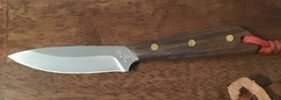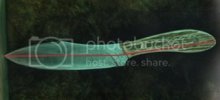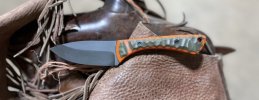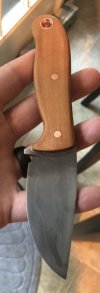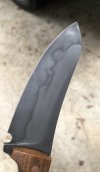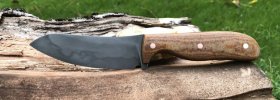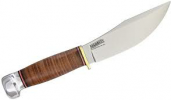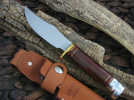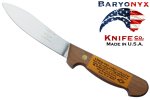deerrockknives
Only thing I’m sure about, I know nothing for sure
Knifemaker / Craftsman / Service Provider
- Joined
- Mar 2, 2020
- Messages
- 526
Hey folks,
I’ve been wanting to post this thread for quite awhile. In my search of bladeforums there has been some talk of this, but really not as much as I think it deserves.
Let me preface by saying I have field dressed probably more animals than most. I used to work as a wildlife biologist and would perform necropsies on hundreds of deer and elk. This is what lead me down the rabbit hole of what makes a good field dressing knife. I’ve used every kind of blade design imaginable and here are some common themes I’ve noticed. Keep in mind I’m nit picking (but isn’t that what the knife hobby is all about?):
-Drop points: good solid design of course. Have you ever noticed though that when you go to resharpen a drop point, the belly of the knife is always substantially more dull than the flat portion of the blade? This bothered me as I felt like I wasn’t using as much of the sharpened edge as I should be. This lead me to a trailing point…
-Trailing point: more gradual belly line I feel allows you to use more of the edge, and the acute point is advantageous in certain scenarios of dressing game. On the flip side, it also can be disadvantageous to have a pointy tip around the guts, hide, etc….this got me thinking more about the handle relationship to the blade.
- When I field dress, I am rarely holding the handle the way it was meant to be held. I typically end up holding it about halfway back in a pinch grip, so I’m allowed to use more of the full edge while processing.
Basically what I’m saying is this: I feel knives that put your knuckles more in line with the edge are far superior for game processing. Think of the Canadian belt knife pattern, or if you’re a folder guy the spyderco spydiechef chef or Kapara (not saying those would be great game processing knives, they just allow your knuckles more clearance). In my experience though, 95% of the hunting knives out there are not designed like this. Why? I’ve read some stuff where people say that it’s better to have the edge in line with the center of your hand because it’s more controllable, but isn’t that just more for woods task? I’m rarely doing that type of stuff. For me, knives are mostly food prep, or game processing.
Anyway, this is a bit of a rant- and food for thought.
I’ve been wanting to post this thread for quite awhile. In my search of bladeforums there has been some talk of this, but really not as much as I think it deserves.
Let me preface by saying I have field dressed probably more animals than most. I used to work as a wildlife biologist and would perform necropsies on hundreds of deer and elk. This is what lead me down the rabbit hole of what makes a good field dressing knife. I’ve used every kind of blade design imaginable and here are some common themes I’ve noticed. Keep in mind I’m nit picking (but isn’t that what the knife hobby is all about?):
-Drop points: good solid design of course. Have you ever noticed though that when you go to resharpen a drop point, the belly of the knife is always substantially more dull than the flat portion of the blade? This bothered me as I felt like I wasn’t using as much of the sharpened edge as I should be. This lead me to a trailing point…
-Trailing point: more gradual belly line I feel allows you to use more of the edge, and the acute point is advantageous in certain scenarios of dressing game. On the flip side, it also can be disadvantageous to have a pointy tip around the guts, hide, etc….this got me thinking more about the handle relationship to the blade.
- When I field dress, I am rarely holding the handle the way it was meant to be held. I typically end up holding it about halfway back in a pinch grip, so I’m allowed to use more of the full edge while processing.
Basically what I’m saying is this: I feel knives that put your knuckles more in line with the edge are far superior for game processing. Think of the Canadian belt knife pattern, or if you’re a folder guy the spyderco spydiechef chef or Kapara (not saying those would be great game processing knives, they just allow your knuckles more clearance). In my experience though, 95% of the hunting knives out there are not designed like this. Why? I’ve read some stuff where people say that it’s better to have the edge in line with the center of your hand because it’s more controllable, but isn’t that just more for woods task? I’m rarely doing that type of stuff. For me, knives are mostly food prep, or game processing.
Anyway, this is a bit of a rant- and food for thought.

